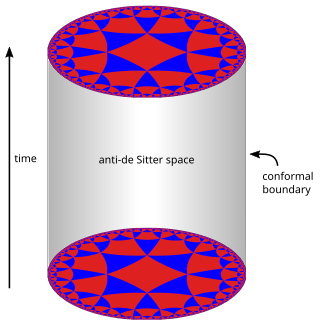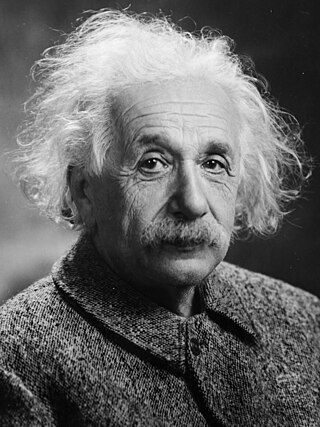
In physics, the special theory of relativity, or special relativity for short, is a scientific theory of the relationship between space and time. In Albert Einstein's 1905 treatment, the theory is presented as being based on just two postulates:
- The laws of physics are invariant (identical) in all inertial frames of reference.
- The speed of light in vacuum is the same for all observers, regardless of the motion of light source or observer.

In physics, spacetime is a mathematical model that fuses the three dimensions of space and the one dimension of time into a single four-dimensional continuum. Spacetime diagrams are useful in visualizing and understanding relativistic effects such as how different observers perceive where and when events occur.
In physics, the twin paradox is a thought experiment in special relativity involving identical twins, one of whom makes a journey into space in a high-speed rocket and returns home to find that the twin who remained on Earth has aged more. This result appears puzzling because each twin sees the other twin as moving, and so, as a consequence of an incorrect and naive application of time dilation and the principle of relativity, each should paradoxically find the other to have aged less. However, this scenario can be resolved within the standard framework of special relativity: the travelling twin's trajectory involves two different inertial frames, one for the outbound journey and one for the inbound journey. Another way of looking at it is to realize the travelling twin is undergoing acceleration, which makes them a non-inertial observer. In both views there is no symmetry between the spacetime paths of the twins. Therefore, the twin paradox is not actually a paradox in the sense of a logical contradiction. There is still debate as to the resolution of the twin paradox.
The world line of an object is the path that an object traces in 4-dimensional spacetime. It is an important concept of modern physics, and particularly theoretical physics.
In physics, in particular in special relativity and general relativity, a four-velocity is a four-vector in four-dimensional spacetime that represents the relativistic counterpart of velocity, which is a three-dimensional vector in space.

In mathematical physics, Minkowski space combines inertial space and time manifolds with a non-inertial reference frame of space and time into a four-dimensional model relating a position to the field.
Time dilation is the difference in elapsed time as measured by two clocks, either because of a relative velocity between them, or a difference in gravitational potential between their locations. When unspecified, "time dilation" usually refers to the effect due to velocity.

In mathematics and physics, n-dimensional anti-de Sitter space (AdSn) is a maximally symmetric Lorentzian manifold with constant negative scalar curvature. Anti-de Sitter space and de Sitter space are named after Willem de Sitter (1872–1934), professor of astronomy at Leiden University and director of the Leiden Observatory. Willem de Sitter and Albert Einstein worked together closely in Leiden in the 1920s on the spacetime structure of the universe. Paul Dirac was the first person to rigorously explore anti-de Sitter space, doing so in 1963.

Length contraction is the phenomenon that a moving object's length is measured to be shorter than its proper length, which is the length as measured in the object's own rest frame. It is also known as Lorentz contraction or Lorentz–FitzGerald contraction and is usually only noticeable at a substantial fraction of the speed of light. Length contraction is only in the direction in which the body is travelling. For standard objects, this effect is negligible at everyday speeds, and can be ignored for all regular purposes, only becoming significant as the object approaches the speed of light relative to the observer.

In relativity, proper time along a timelike world line is defined as the time as measured by a clock following that line. The proper time interval between two events on a world line is the change in proper time, which is independent of coordinates, and is a Lorentz scalar. The interval is the quantity of interest, since proper time itself is fixed only up to an arbitrary additive constant, namely the setting of the clock at some event along the world line.
Rindler coordinates are a coordinate system used in the context of special relativity to describe the hyperbolic acceleration of a uniformly accelerating reference frame in flat spacetime. In relativistic physics the coordinates of a hyperbolically accelerated reference frame constitute an important and useful coordinate chart representing part of flat Minkowski spacetime. In special relativity, a uniformly accelerating particle undergoes hyperbolic motion, for which a uniformly accelerating frame of reference in which it is at rest can be chosen as its proper reference frame. The phenomena in this hyperbolically accelerated frame can be compared to effects arising in a homogeneous gravitational field. For general overview of accelerations in flat spacetime, see Acceleration and Proper reference frame.
In physics, Albert Einstein derived the theory of special relativity in 1905 from principle now called the postulates of special relativity. Einstein's formulation is said to only require two postulates, though his derivation implies a few more assumptions.
The history of special relativity consists of many theoretical results and empirical findings obtained by Albert A. Michelson, Hendrik Lorentz, Henri Poincaré and others. It culminated in the theory of special relativity proposed by Albert Einstein and subsequent work of Max Planck, Hermann Minkowski and others.
In a relativistic theory of physics, a Lorentz scalar is an expression, formed from items of the theory, which evaluates to a scalar, invariant under any Lorentz transformation. A Lorentz scalar may be generated from e.g., the scalar product of vectors, or from contracting tensors of the theory. While the components of vectors and tensors are in general altered under Lorentz transformations, Lorentz scalars remain unchanged.
What is now often called Lorentz ether theory (LET) has its roots in Hendrik Lorentz's "theory of electrons", which marked the end of the development of the classical aether theories at the end of the 19th and at the beginning of the 20th century.

In physics, the relativity of simultaneity is the concept that distant simultaneity – whether two spatially separated events occur at the same time – is not absolute, but depends on the observer's reference frame. This possibility was raised by mathematician Henri Poincaré in 1900, and thereafter became a central idea in the special theory of relativity.

Albert Einstein presented the theories of special relativity and general relativity in publications that either contained no formal references to previous literature, or referred only to a small number of his predecessors for fundamental results on which he based his theories, most notably to the work of Henri Poincaré and Hendrik Lorentz for special relativity, and to the work of David Hilbert, Carl F. Gauss, Bernhard Riemann, and Ernst Mach for general relativity. Subsequently, claims have been put forward about both theories, asserting that they were formulated, either wholly or in part, by others before Einstein. At issue is the extent to which Einstein and various other individuals should be credited for the formulation of these theories, based on priority considerations.

A spacetime diagram is a graphical illustration of locations in space at various times, especially in the special theory of relativity. Spacetime diagrams can show the geometry underlying phenomena like time dilation and length contraction without mathematical equations.
This article will use the Einstein summation convention.
Accelerations in special relativity (SR) follow, as in Newtonian Mechanics, by differentiation of velocity with respect to time. Because of the Lorentz transformation and time dilation, the concepts of time and distance become more complex, which also leads to more complex definitions of "acceleration". SR as the theory of flat Minkowski spacetime remains valid in the presence of accelerations, because general relativity (GR) is only required when there is curvature of spacetime caused by the energy–momentum tensor. However, since the amount of spacetime curvature is not particularly high on Earth or its vicinity, SR remains valid for most practical purposes, such as experiments in particle accelerators.



















